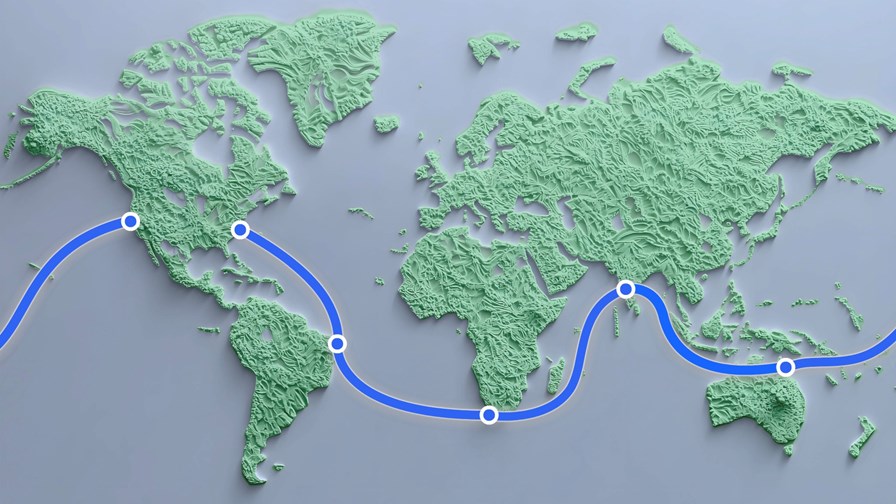
Meta's planned route for the global Project Waterworth subsea cable.
- Meta is to invest billions in a new submarine network that will span the globe
- It has been dubbed Project Waterworth
- It will connect the Americas, Africa and Asia – but not Europe
In a bid to guarantee access to vital international data networking capacity to support its AI and cloud traffic, big tech giant Meta is to invest billions of dollars in a subsea cable network, called Project Waterworth, that will span the globe, have landing stations on five continents and be more than 50,000km long.
According to Meta, once completed, it will be “the world’s longest subsea cable project using the highest-capacity technology available”, with landing points in the US, India, Brazil, South Africa and Australia but, as the map above shows, not Europe.
Project Waterworth is the official name for what had been unveiled late last year as a project dubbed ‘W’ (because of the shape of the cable’s intended route around the continents). At that time, subsea network industry veteran Sunil Tagare noted that the initial cost of deployment would be around $2bn, with costs in the region of $5bn to $10bn over the next five to 10 years. He also pointed out that the cable’s planned route avoids “the Red Sea, the South China Sea and more importantly Egypt, Marseilles, the Straits of Malacca and Singapore”, all of which, according to Tagare, are “major single points of failure” in the global subsea network sector. (That explains the lack of Project Waterworth landing points in Europe.)
The company isn’t new to the submarine network sector – it is already a key player in more than 20 subsea networks, including 2Africa (Africa, Europe, Middle East), Marea (Spain to the US), the Asia-Pacific Gateway and Jupiter (north-east Asia to the US), developed over the years to help connect the company’s many datacentre facilities.
Meta notes that “subsea cables projects, such as Project Waterworth, are the backbone of global digital infrastructure, accounting for more than 95% of intercontinental traffic across the world’s oceans… Project Waterworth will be a multibillion-dollar, multi-year investment to strengthen the scale and reliability of the world’s digital highways by opening three new oceanic corridors with the abundant, high-speed connectivity needed to drive AI innovation around the world.”
And it’s going to be a fat pipe. “With Project Waterworth, we continue to advance engineering design to maintain cable resilience, enabling us to build the longest 24 fibre-pair cable project in the world and enhance overall speed of deployment. We are also deploying first-of-its-kind routing, maximising the cable laid in deep water – at depths up to 7,000 metres – and using enhanced burial techniques in high-risk fault areas, such as shallow waters near the coast, to avoid damage from ship anchors and other hazards,” added Meta. Damage from ship anchors is, of course, quite a hot topic currently…
The move makes sense. Big tech firms (and other large enterprises) around the world are figuring out how best to provide secure, guaranteed connectivity to their digital infrastructure as the volumes of AI-fuelled data grow at a furious pace, and while most turn to telcos for their connectivity, some have the financial and operational muscle to build and run their own long-distance networks – one of those is Meta.
And, as you’d expect, Meta calls out the current AI boom as a catalyst for the investment. “AI is revolutionising every aspect of our lives, from how we interact with each other to how we think about infrastructure – and Meta is at the forefront of building these innovative technologies. As AI continues to transform industries and societies around the world, it’s clear that capacity, resilience, and global reach are more important than ever to support leading infrastructure. With Project Waterworth we can help ensure that the benefits of AI and other emerging technologies are available to everyone, regardless of where they live or work.”
While investment in more subsea cable capacity is good news for the global digital economy and for meeting end user expectations (in this case, Meta’s users’ expectations), not everyone sees this as totally positive. Sunil Tagare noted in a recent LinkedIn post that the international subsea sector is being squeezed and increasingly dominated by Meta and Google to the detriment of competitive network operators such as Aqua Comms, which was recently acquired for a very low price
- Ray Le Maistre, Editorial Director, TelecomTV
Email Newsletters
Sign up to receive TelecomTV's top news and videos, plus exclusive subscriber-only content direct to your inbox.
Subscribe